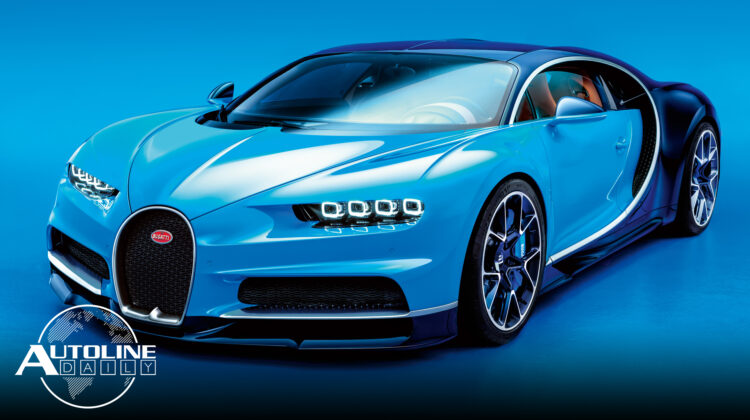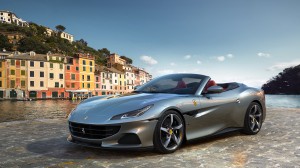
Listen to “AD #2919 – Volkswagen Dumps Bugatti; LG Chem Spins Off Battery Business; Ferrari Debuts Portofino M” on Spreaker.
Follow us on social media:
Runtime: 10:39
0:07 GM India Plant Sale to Great Wall Delayed
0:49 Volkswagen Selling Bugatti to Rimac
1:41 LG Chem Spins Off Battery Business
2:20 ChargePoint Close to Going Public Through Reverse Merger
3:36 Ford Retools Plant for Electric F-150
4:26 ZF Shares Wrangler PHEV Performance Numbers
6:12 Electrify America Switches to Charging by kWh
8:42 Ferrari Debuts Portofino M
9:37 Cadillac Dealers Have to Spend 200K to Sell EVs
Visit our sponsors to thank them for their support of Autoline Daily: Bridgestone and Intrepid Control Systems.
This is Autoline Daily, the show dedicated to enthusiasts of the global automotive industry.
GM INDIA PLANT SALE TO GREAT WALL DELAYED
Border tensions between India and China are impacting General Motors. It wants to sell its assembly plant in India to China’s Great Wall Motors. The deal, which was worth between $250 to $300 million, was expected to close in the second half of the year. But India and China are engaged in an arms buildup on a disputed part of their border. And India is not exactly keen on bringing a Chinese car company into the country right now. The deal will likely still happen but it’s up in the air as to when. And this shows why you really have to pay attention to geopolitical events to know what’s going to happen in the global automotive industry.
VOLKSWAGEN SELLS BUGATTI TO RIMAC
Big news in exotic sports cars today. The Volkswagen Group is going to sell off Bugatti to specialty maker Rimac. Bugatti is clearly not a core asset for VW. It only sold 82 cars last year. Even with an average selling price over $3 million, Bugatti only generates about $250 million a year in revenue. Just to give you an idea, that’s not enough to pay for designing a new transmission. And Bugatti is not the only brand VW is looking to get rid of. CAR magazine reports that Lamborghini, Seat, Bentley, Ducati and ItalDesign could also go on the auction block. VW burned through billions of euros due to its diesel cheating scandal, and it has to invest heavily in electric cars, and one of the fastest ways to get cash is to sell off assets.
LG CHEM SPINS OFF BATTERY BUSINESS
Talk about potentially unlocking the value of a company. LG Chem says it’s spinning off its battery business into a new company, which will include batteries for smartphones and laptops, as well as electric vehicles. Even though LG Chem’s battery business has never posted an annual profit, it did post one in the most recent quarter. And the company believes that growth will continue due to automakers introducing more and more electric vehicles. The new company, called LG Energy Solutions, will launch in December and is aiming for $25.5 billion in revenue or more by 2024.
CHARGEPOINT CLOSE TO GOING PUBLIC THROUGH REVERSE MERGER
Another day, another reverse merger. This time it’s the EV charging network ChargePoint, which is closing in on a deal to go public with Switchback Energy Acquisition. The deal could value ChargePoint at more than $2 billion. For those of you that don’t know, a reverse merger is where a company that is already listed on the stock exchange goes bankrupt and sells its assets but keeps its legal standing and then another company that wants to go public can merge with it. This has become very popular with automotive startups recently. Nikola Motors, Fisker, Lordstown Motors, Velodyne and Proterra have all gone or are trying to go public with reverse mergers.
FORD RETOOLS PLANT FOR ELECTRIC F-150
Ford is investing $700 million in its historic Rouge plant to build an electric version of the F-150 pickup. That includes a new separate building for final assembly and battery pack assembly. The truck will use the existing body shop and paint shop, but Ford wants a separate building for final assembly so the electric version doesn’t reduce manufacturing capacity for the ICE version. The electric truck will use two motors and Ford brags, it will have the most horsepower and torque of any F-150 as well as the fastest acceleration and best towing capability. Last year Ford showed a prototype towing a train. Ford execs also gush that it will have a massive frunk because the EV powertrain is so much smaller than an ICE one.
ZF SHARES WRANGLER PHEV PERFORMANCE NUMBERS
We’re learning more about the plug-in version of the Wrangler. But the information is not coming from Jeep, it’s coming from ZF. That’s because the giant German supplier is making the 8-speed transmission for the Wrangler that incorporates a powerful electric motor. It cranks out 100 kilowatts of power and 245 Newton meters of torque. That’s about 145 horsepower and 180 foot pounds of torque. ZF says the 8-speed is a modular design and can fit a variety of applications so we expect it to be in all of Jeep’s PHEV models, and probably on other FCA models.
Speaking of ZF, we’re going to have Jorg Trampler, the head of engineering in North America, on Autoline After Hours later this afternoon. As we keep pointing out, automotive suppliers are a fountain of innovation. Bill Visnic from SAE Automotive Engineering will also be on the show. So get ready for a really good nuts and bolts discussion of powertrain and drivetrain technology.
Then mark down your calendars for next Wednesday at 11 am eastern time. We’re going to do a special, live hour-long post mortem of Tesla’s Battery Day. And we’re bringing Bob Galyen and Sandy Munro on board to give you some of the smartest insights from two of the foremost EV experts in the world. If you have questions you’d like to pose to Bob and Sandy, send an email to viewermail@autoline.tv or send a tweet to @Autoline.
ELECTRIFY AMERICA SWITCHES TO CHARGING BY KWH
Electrify America is rolling out a new pricing structure in the U.S. and the District of Columbia that will make users of its charging network happier. It’s switching from per-minute pricing to charging by the kWh. That rate is $0.31 per kWh, if you pay a $4 monthly fee. It’s $0.43 per kWh without the fee. And that’s no matter the charging speed, from 1 to 350 kW, or the location you’re in. Well, sort of. Some states don’t allow charging by the kWh, so per-minute pricing is all that’s available to EV owners. It has something to do with state regulation that won’t allow entities to resell electricity. I believe there’s currently 30 states that allow charging by the kWh. Electrify America will offer the pricing structure in 23 states, presumably because it doesn’t have charging sites in the other seven states. California also enacted legislation that will require stations to charge by the kWh. But this is really the best way to go. It’s the EV equivalent of dollars per gallon. What you put in is what you pay for. At per-minute charging stations it can be something of a crapshoot. For example, you still pay the same price even if it’s freezing cold out and the station is charging your EV at a slower rate than if it were warm. Almost all EV owners seem to agree with Tesla who says charging by the kWh is “the most fair and simple method.” Electrify America even says right in its press release it switched to the new structure based on customer feedback that it’s the best way to charge for charging. In our opinion it should even help in the adoption of EVs because it’s more transparent and so similar to paying by the gallon. In the remaining states where per-minute pricing is still the only option, Electrify America is simplifying and reducing its rates. It’s $0.12 a minute for charging at 90 kW and below and $0.24 for anything above that. Oh, and don’t think we’d leave you hangin’. According to Tesla’s website, it charges $0.28 per kWh. And, of course, we’d love to know what any of our EV owning viewers are paying to charge their vehicle.
FERRARI DEBUTS PORTOFINO M
Ferrari introduced a new version of its hard-top convertible the Portofino, called the Portofino M. The ‘M’ stands for ‘Modificata,’ which in the Ferrari world means a model with significantly boosted performance. In the Portofino M’s case that means about 20 more horsepower from its turbo V8, which now makes about 620 horsepower. All that power is pumped through a new 8-speed DCT and then routed out a new exhaust system, which is less restrictive and boosts sound. Unique styling elements, in the form restyled air intakes, a new air vent in front of the wheel arch, aluminum slats in the grille and a more streamlined rear end, help convey that this is a special Ferrari. No word on pricing but a standard Portofino starts at $215,000.
CADILLAC DEALERS HAVE TO SPEND 200K TO SELL EVs
Cadillac dealers are going to have to pony up some dough if they want to sell the automaker’s EVs. The Detroit News reports that dealers will have to spend an estimated $200,000 so “they can meet customer expectations and have the right facilities and infrastructure in place.” That amount includes tooling, training and installation of charging stations, which they’ll have to start preparing for by the 2nd quarter of next year. Cadillac wants its dealers ready for when the Lyriq launches in the U.S. in late 2022. And while 200-grand might seem like a lot to you and I, it’s really not all that big of a deal for a decent-sized dealership.
But that wraps up today’s show. Thanks for watching.
Thanks to our partner for embedding Autoline Daily on its website: WardsAuto.com

John McElroy is an influential thought leader in the automotive industry. He is a journalist, lecturer, commentator and entrepreneur. He created “Autoline Daily,” the first industry webcast of industry news and analysis.







